Advantage Norris in Brazil. Then red flag set up Verstappen masterclass
Max Verstappen all but clinched this year's Formula 1 championship with a masterful drive in the wet 2024 Sao Paulo Grand Prix, while Lando Norris was left rueing a red flag that ended his hopes of victory

Unleashed at the front, Verstappen pulled out a 19sec lead
Clive Mason/Getty via Red Bull
Off the back of their clashes in the previous two races, the title contenders Max Verstappen and Lando Norris came into the Sao Paulo Grand Prix weekend separated by 47 points. Which meant Norris needed to out-score his rival by an average of almost 12 points per meeting if he was to become world champion. This seemed unlikely – but the Brazilian track does have a reputation for randomising. It certainly added to that this weekend, with Saturday qualifying rained off and the Sunday session subject to five red flags in the treacherous conditions.
The fortunes of the two contenders swung dramatically throughout the weekend as Interlagos lived up to its reputation. But ultimately it lay witness to a Verstappen masterclass to victory from 17th on the grid. Here’s how it played out.
Verstappen PU replacement
A new power unit outside of his allocation meant Verstappen would be taking a five-place grid hit here. “We chose to do it here because at least it’s a track on which you can overtake,” explained team boss Christian Horner.
Advantage Norris.
McLaren new rear wing boost
McLaren came here with an all-new medium downforce rear wing, with a significantly more efficient trade-off between downforce and drag, but with an especially useful improvement in its DRS performance.
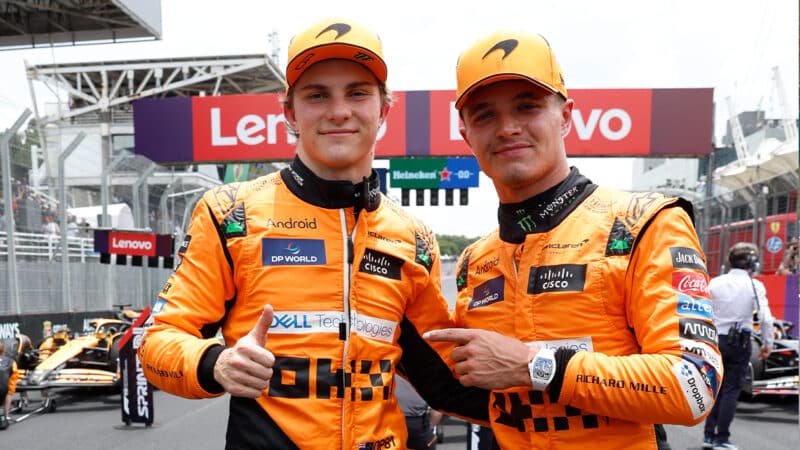
Sprint pole for Piastri and Norris second on the grid with new McLaren wing
McLaren
It worked extremely well in the dry Friday running. Norris was fastest in the single practice session (with the proviso that Verstappen didn’t do any qualifying simulation, concentrating because of his grid penalty on race prep) and the McLarens then locked out the front row in sprint qualifying, with fourth-fastest Verstappen 0.291sec adrift of pole-sitter Oscar Piastri.
Norris had made a small error on his final Q3 run, putting him 0.07sec behind his team-mate but Piastri went into the sprint on Saturday morning knowing he’d be asked to surrender position to Norris if they were running 1-2 with Piastri ahead. They were, he did. Though it was a little more stressful than it might have been, Oscar only handing over a couple of laps from the end when a VSC threatened to lock them in position. Verstappen put a little pressure on them after getting by Charles Leclerc’s Ferrari, but nothing they couldn’t handle.
More advantage Norris.
Rain
In hindsight this is where the Norris advantage began to come undone. Torrential rain meant the scheduled GP qualifying couldn’t happen on Saturday. The track was just barely driveable for early Sunday morning, with the Grand Prix brought forward to avoid the worst of the weather.
The qualifying sessions were crazily chaotic. Just keeping a car on track was a feat in itself and there were five red flags as they hit various bits of the scenery. Verstappen cooly met the challenges in Q1, going comfortably fastest. Norris only barely avoided going out at this stage, just scraping into Q2, around 2sec slower than the Red Bull.
It looked like the necessary switch to the big wing in anticipation of the weather had blunted the McLaren’s competitiveness a little. It definitely no longer had the handy pace advantage over the Red Bull it had enjoyed in the dry with the smaller wing.
Advantage Verstappen?
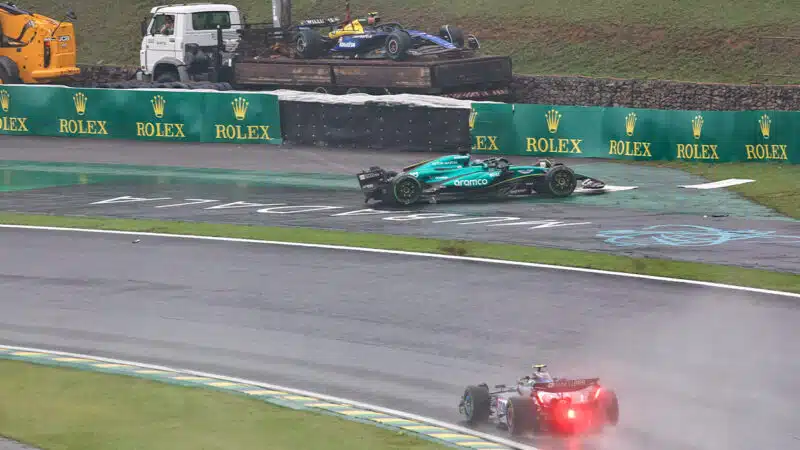
Verstappen lost out when Stroll crashed
Alessio Morgese/Getty
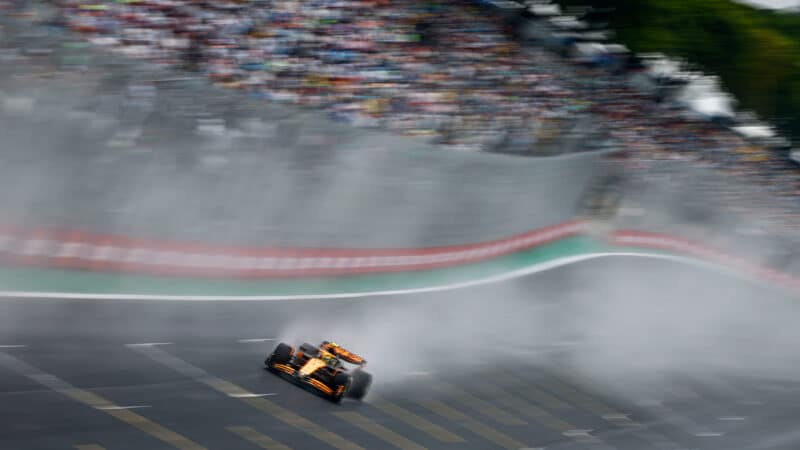
Norris improved to take GP pole
McLaren
But then the Interlagos randomness bit again. Norris, with his tyres properly prepared this time, went quickest in Q2. Verstappen was just coming out for his second run on an improving (but still wet) track when Lance Stroll crashed, bringing out the red flags, with not enough time left to restart the session. But they were brought out only after race control had waited to see if Stroll succeeded in reversing out and continuing. In that half-minute or so, many drivers improved their times and knocked Verstappen out of the top 10. He was almost speechless with rage. P12 with a five-place penalty = P17 starting slot.
His mood was probably not improved by Norris taking pole in Q3 – albeit only barely from a super-impressive George Russell, despite his Mercedes being a bit of a bouncing, brake-locking handful.
Advantage Norris.
Race
The track remained wet, the rain varied in intensity. But it was inters for everyone. That Verstappen would deliver a spectacular performance in the wet from 17th on the grid was a given. But he was starting 16 places behind Norris.
Things didn’t go great for Lando at the start, as he lost out to Russell off the line. Verstappen meanwhile was up to 10th by lap 2 and would steadily pick off cars until he was on the tail of a Tsunoda–Ocon-Leclerc train in 3rd/4th/5th/6th after just a dozen laps.
Norris’s big wing had brought wet track lap time but at the expense of straightline speed. The Mercedes was significantly faster at the end of the straights and Norris found himself stuck behind a slower car as Verstappen made up all those positions.
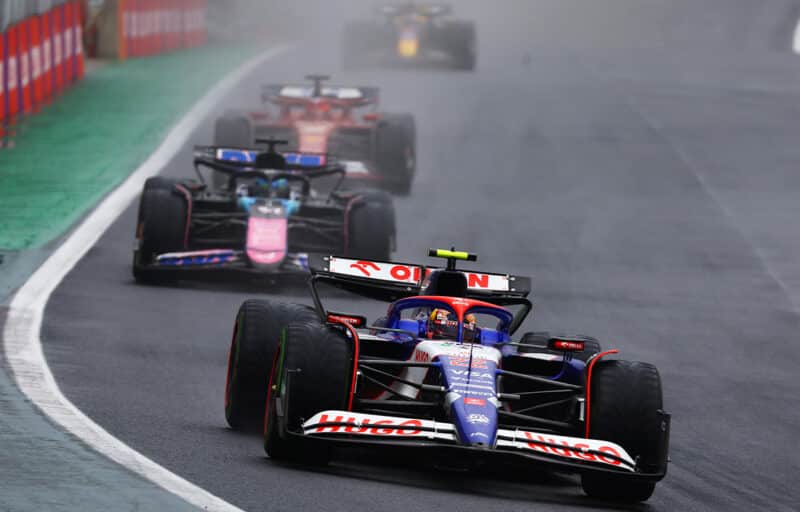
Verstappen was temporarily stuck behind a train of cars led by Tsunoda
Mark Thompson/Getty via Red Bull
But then Verstappen’s challenge was neutralised by the slipstream effect, as the three slower cars in front of him kept him at arm’s length at the end of the straights. Norris, although still unable to find a way by race-leader Russell, was 14sec clear of Verstappen and the race was 28 laps old, with 41 to go.
Advantage Norris?
The decisive swing
The track was getting wetter and everyone’s inters were becoming worn-out. Norris was urging McLaren to bring him in to undercut past Russell. McLaren was countering it couldn’t do that yet as there wasn’t a good gap to drop him into. They needed another couple of laps to clear Tsunoda’s third-place RB.
But then Nico Hülkenberg dropped his Haas, triggering the virtual safety car and the promise of a time-cheap pitstop. So that’s when McLaren brought Norris in – and Mercedes did the same with Russell. Much against Russell’s wishes. He’d wanted not to stop and to instead wait for the red flag he felt was inevitable. Such was the state of the track as the rain came on harder.
The VSC was rescinded before they even got to their pit boxes, meaning it was no longer a time-cheap stop and that they would be losing track position to Ocon, Verstappen and the other Alpine of Pierre Gasly, all of whom had stayed out. The danger of staying out was a safety car. Which would compress the field and ensure that any stop you made for tyres would lose you a disastrous number of positions – or leave you a sitting duck on old tyres at the restart. Then came the safety car. Briefly it was advantage Norris again. Especially as he had finally passed Russell on their out-laps.
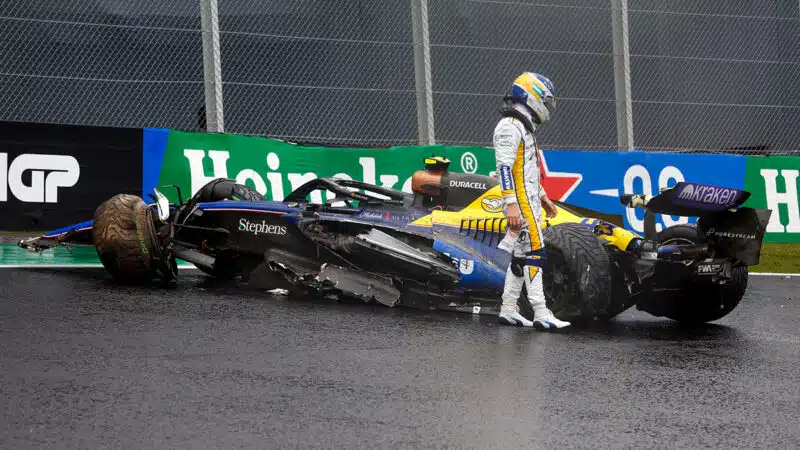
Colapinto crash brought out the red flag
DPPI

Verstappen takes the lead at the restart
Getty via Red Bull
But two laps later the safety car was replaced by the red flag as Franco Colapinto crashed his Williams (just as had Alex Albon in qualifying, making him a non-starter). Ocon, Verstappen and Gasly were off the hook, able to get their tyre changes done at the stoppage without any time penalty at all.
Which had vaulted Verstappen from four places and 14sec behind Norris to two places in front of him. It was the crucial bit of circumstance which decided the outcome. Verstappen subsequently passed Ocon on a second restart and pulled easily away. Norris locked up his rear brakes and lost three positions on one of those restarts and although Piastri gave him one back, he didn’t have the straightline speed to pass Leclerc’s slow Ferrari (Charles admitting he’d gone totally the wrong way on set up and Carlos Sainz having started from the pitlane in the other Ferrari after crashing in qualifying, only to do so again in the race).
Like that, Verstappen added to his legend and made his title prospects look almost certain.
Advantage very much Verstappen.
